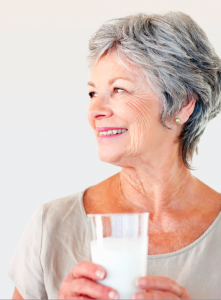 If you’re over 40, you may not think much about your risk for osteoporosis as you age. However, around the world, 1 in 3 women, and 1 in 5 men, over 50 will experience osteoporosis in their lifetime. Even more sobering is the fact that osteoporosis causes a fracture every 3 seconds! That’s right. But getting older doesn’t have to include osteoporosis. You’ll want to learn how to understand your possible risk for osteoporosis and what you can do to reduce that risk. Let me tell you how.
If you’re over 40, you may not think much about your risk for osteoporosis as you age. However, around the world, 1 in 3 women, and 1 in 5 men, over 50 will experience osteoporosis in their lifetime. Even more sobering is the fact that osteoporosis causes a fracture every 3 seconds! That’s right. But getting older doesn’t have to include osteoporosis. You’ll want to learn how to understand your possible risk for osteoporosis and what you can do to reduce that risk. Let me tell you how.
How to Minimize Your Risk for Osteoporosis
Osteoporosis can take a huge toll on your personal health, what activities you participate in, and your economic security. Major fractures – like those of the hip and vertebral spine – can impair your ability to get around, work, and may necessitate being dependent on others. It can mean that you will have to enter assisted living or even a nursing home. These fractures occur most often between the ages of 75-79, but the risk of them increases after age 50.
A less debilitating, but more common fracture, of the wrist/forearm occurs most often in women over 50 who have fallen. Osteoporosis is more common in women – especially postmenopausal women – but it does occur in men as well.
So what can you do to minimize your risk of being affected by osteoporosis? The following are some ways to become proactive now to decrease your risk of suffering debilitating fractures from osteoporosis later in your life.
1. Heredity. For some people the risk of osteoporosis is higher in families where parents, grandparents, etc, may have had osteoporosis. Yet, you can still decrease your risk by omitting bone-losing activities, and increasing bone-building activities.
2. Smoking. If you smoke, quit. It is one of the major contributing factors to decreasing BMD (bone mineral density) and greatly increases your risk of developing osteoporosis. The toxins in smoke can cause damage to blood vessels that feed your bones. Without enough blood to feed them, their inner structures don’t get enough nutrients for healthy growth. Smoking also greatly decreases Vitamin C content – a major antioxidant – which also has a protective effect on bone health. Recent 2012 research out of Mount Sinai’s Medical School has shown that Vitamin C directly protects against osteoporosis by stimulating bone formation and mass. Be sure to get at least 500 mg a day of Vitamin C – even 1,000 mg through foods and/or supplements.
3. Physical activity. Sedentary people have much higher risks for osteoporosis than do physically active people. Doing bone building exercise (ground/floor impact types) 3-4 times a week such as running, walking, playing basketball, football, soccer, tennis all increase your bone density and decrease risk for osteoporosis. Muscle building exercise, like lifting weights, greatly helps build bone as well. Strong muscles rub against bones during movement causing friction which stimulates bone growth.
4. Alcohol. Too much alcohol (more than 7 drinks a week for women, and 14 for men) contributes to bone density loss.
5. Diet. Be sure your nutrition is optimal to keep your bones their healthiest. This includes vitamins like C, K, and D3, as well as minerals zinc, magnesium and silicon. Stay away from sodas as the phosphorus in them can leach calcium from your bones. In addition, too high salt diets can impair calcium absorption. There’s been a lot of controversy about taking calcium supplements lately, so I recommend getting calcium from food sources first, unless you already have a bone issue which requires you to take added supplements. Get about 300 mg of calcium, 4 times a day, to total about 1200 mg per day. Drinking 8 oz of cow, almond, or soymilk can do this; eating 1 serving of yogurt or 8 ounces of cheese; eating ¼ cup of almonds or 1 serving of calcium fortified cereal or orange juice, 3-4 times a day. Many other foods also contain good levels of calcium like broccoli, bok choy, soybeans, salmon, legumes, etc.
6. Medications. If you take steroids, thyroid replacement, antidepressants, aromatase-inhibitor cancer drugs you are at a somewhat higher risk for developing osteoporosis. Ask your doctor if there is another way to treat your condition, or what is the lowest, yet effective, dose you can take of these medications. If you must take them, be sure to offset their possible effects with other bone-building activities.
7. Hormones. If you’re an over 45, post-menopausal woman, or post-andropausal male, you may want to find a doctor skilled in bioidentical hormone replacement. Bone loss starts to speed up after age 45 from estrogen and testosterone deficiencies. Replacing these hormones to youthful levels can help rebuild bone mineral density. Yearly DEXA (bone mineral density studies) can tell your doctor where your bone health is.
Osteoporosis, and the loss of independence and fragility it can bring, doesn’t have to be part of your life, as you get older. No matter what your age is now, if you take some proactive steps to decrease your risks, your chance of suffering a debilitating fracture from osteoporosis when you’re older will be much less.
Stay Well,
Mark Bromson, M.D.
Natural Health News
Osteoporosis: Facts and Statistics http://www.iofbonehealth.org/facts-statistics
Vitamin C Prevents Bone Loss in Animal Modes, http://www.sciencedaily.com/releases/2012/10/121009151258.htm
Photo credit: assistedlivingmablog.com
